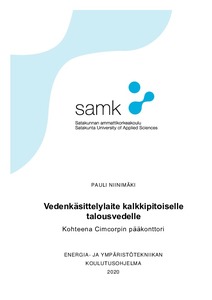Vedenkäsittelylaite kalkkipitoiselle talousvedelle: Kohteena Cimcorpin pääkonttori
Niinimäki, Pauli (2020)
Niinimäki, Pauli
2020
All rights reserved. This publication is copyrighted. You may download, display and print it for Your own personal use. Commercial use is prohibited.
Julkaisun pysyvä osoite on
https://urn.fi/URN:NBN:fi:amk-202004084813
https://urn.fi/URN:NBN:fi:amk-202004084813
Tiivistelmä
Talousveden kalkkipitoisuudelle ei ole määritelty enimmäisarvoa, vaikka vedessä oleva kalkki aiheuttaa teknisiä ja esteettisiä haittoja veden käyttäjille. Saostuessaan kalkki tukkii ja värjää vesikalusteita sekä vesijohtoja. Toisaalta kalkki myös vähentää veden syövyttävyyttä. Vedenkäyttäjät voivat estää kalkkipitoisen veden aiheuttamat haitat käsittelemällä vettä vedenpehmentimillä, käänteisosmoosilaitteilla tai kalkinmuuntimilla.
Opinnäytetyön tarkoituksena oli selvittää, millaisilla menetelmillä talousveden käyttäjä voi vähentää kalkkipitoisen veden aiheuttamia haittoja. Tavoitteena oli löytää tehokkain vedenkäsittelylaite kalkkipitoiselle talousvedelle Cimcorpin kiinteistöön. Tarkastelussa huomioitiin kustannukset sekä vaikutukset vedenlaatuun ja syövyttävyyteen.
Työhön sisältyi veden laadun selvittäminen, järjestelmien esittely, toteutuksen suunnittelu, kustannusten selvittäminen ja parhaan ratkaisun suosittelu. Työssä suositeltu vedenkäsittelylaite on vedenpehmennin. Suositus tehtiin teoreettisen tiedon, tarjousten ja suunnittelun perusteella. Veden pehmentimeen päädyttiin laitteen edullisuuden ja toimintavarmuuden takia.
Työn perusteella voidaan todeta, että kalkkipitoisen veden käsittelyssä käänteisosmoosilaitteiden investointikustannus on korkeampi ja hyötysuhde huonompi kuin muilla menetelmillä. Kalkinmuuntimien tehokkuus vaihtelee laitekohtaisesti ja käyttökohteittain. Niiden toimivuudesta on paljon ristiriitaisia mielipiteitä, minkä vuoksi laitteiden tehokkuudesta tarvittaisiin enemmän luotettavia tutkimuksia.
Liitteet kolme ja neljä ovat luottamuksellisia, joten niitä ei esitetä tässä julkisessa opinnäytetyössä. Maximum limit for lime in household water has not been regulated although lime in the water causes both technical and esthetical disadvantages for the people using it. Precipitated lime shuts and stains water fixtures and water pipes. On the other hand, lime also reduces the corrosivity of water. Water users can prevent the disadvantages of limewater by treating the water with water softener, reverse osmosis and physical water treatment devices.
The purpose of this thesis was to find out methods for reducing the harm caused by lime water as a household water user. The objective of the work was to find the most efficient water treatment device for the limewater at the Cimcorp property. The comparison considered the costs as well as the effects on water quality and corrosivity.
The work included analysis of water quality, introduction and design of the systems, cost investigation and recommendation of the best solution. The recommended water treatment device is a water softener. The recommendation is based on theoretical knowledge, quotations and design. The water softener was chosen because of the affordability and reliability of the device.
As a conclusion, it can be stated that in case of limewater treatment, the investment costs and efficiency are higher with reverse osmosis device compared to other methods. The efficiency of physical water treatment devices varies by device and application. There are many different opinions about their performance, which would require more reliable research about effectiveness of the devices.
Appendices three and four are confidential and therefore they will not be introduced in this public thesis.
Opinnäytetyön tarkoituksena oli selvittää, millaisilla menetelmillä talousveden käyttäjä voi vähentää kalkkipitoisen veden aiheuttamia haittoja. Tavoitteena oli löytää tehokkain vedenkäsittelylaite kalkkipitoiselle talousvedelle Cimcorpin kiinteistöön. Tarkastelussa huomioitiin kustannukset sekä vaikutukset vedenlaatuun ja syövyttävyyteen.
Työhön sisältyi veden laadun selvittäminen, järjestelmien esittely, toteutuksen suunnittelu, kustannusten selvittäminen ja parhaan ratkaisun suosittelu. Työssä suositeltu vedenkäsittelylaite on vedenpehmennin. Suositus tehtiin teoreettisen tiedon, tarjousten ja suunnittelun perusteella. Veden pehmentimeen päädyttiin laitteen edullisuuden ja toimintavarmuuden takia.
Työn perusteella voidaan todeta, että kalkkipitoisen veden käsittelyssä käänteisosmoosilaitteiden investointikustannus on korkeampi ja hyötysuhde huonompi kuin muilla menetelmillä. Kalkinmuuntimien tehokkuus vaihtelee laitekohtaisesti ja käyttökohteittain. Niiden toimivuudesta on paljon ristiriitaisia mielipiteitä, minkä vuoksi laitteiden tehokkuudesta tarvittaisiin enemmän luotettavia tutkimuksia.
Liitteet kolme ja neljä ovat luottamuksellisia, joten niitä ei esitetä tässä julkisessa opinnäytetyössä.
The purpose of this thesis was to find out methods for reducing the harm caused by lime water as a household water user. The objective of the work was to find the most efficient water treatment device for the limewater at the Cimcorp property. The comparison considered the costs as well as the effects on water quality and corrosivity.
The work included analysis of water quality, introduction and design of the systems, cost investigation and recommendation of the best solution. The recommended water treatment device is a water softener. The recommendation is based on theoretical knowledge, quotations and design. The water softener was chosen because of the affordability and reliability of the device.
As a conclusion, it can be stated that in case of limewater treatment, the investment costs and efficiency are higher with reverse osmosis device compared to other methods. The efficiency of physical water treatment devices varies by device and application. There are many different opinions about their performance, which would require more reliable research about effectiveness of the devices.
Appendices three and four are confidential and therefore they will not be introduced in this public thesis.
